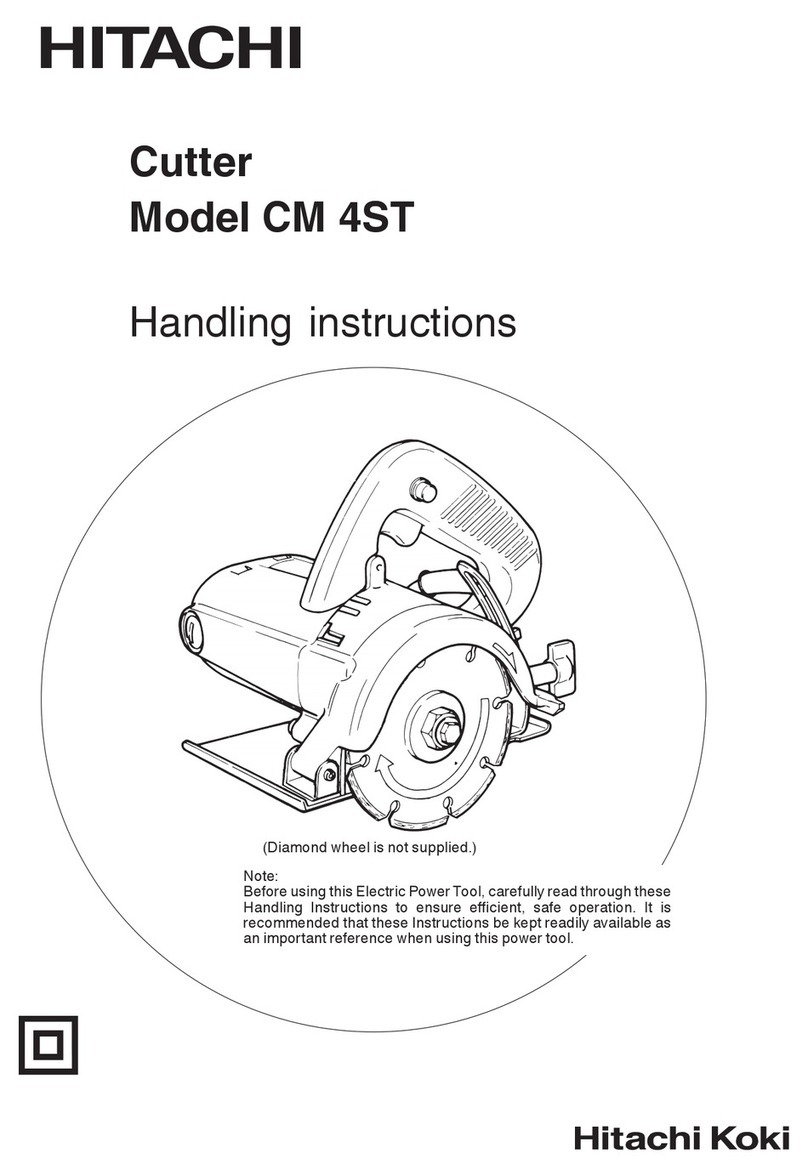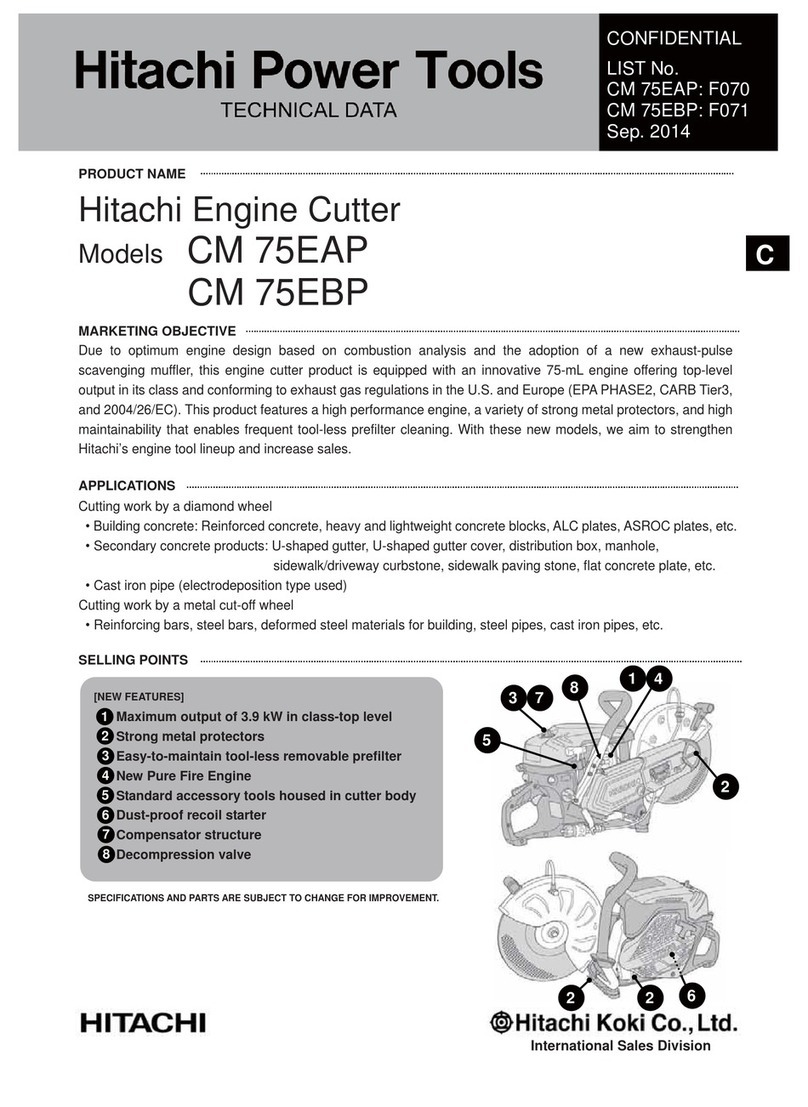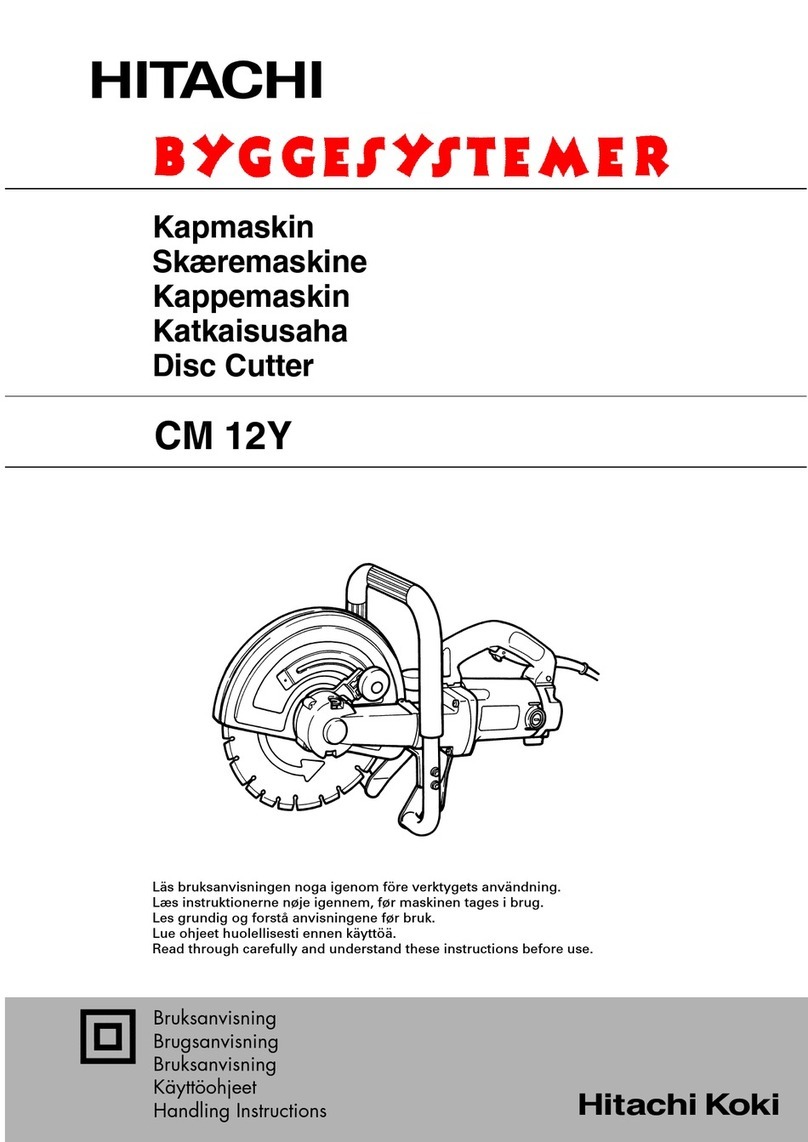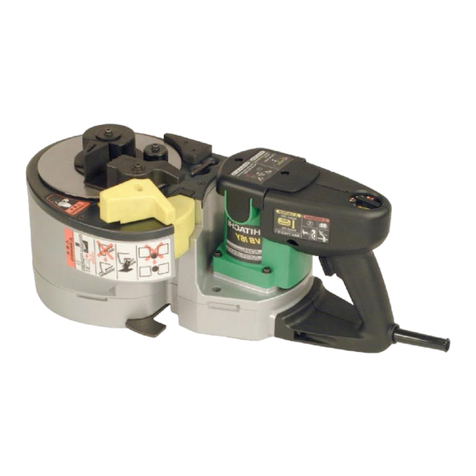
5
English
PRECAUTIONS ON USING CUTTER
1. The guard provided with the tool must be securely
attached to the power tool and positioned for maximum
safety, so the least amount of wheel is exposed towards
the operator. Position yourself and bystanders away from
the plane of the rotating wheel.
The guard helps to protect operator from broken wheel
fragments and accidental contact with wheel.
2. Use only diamond cut-offwheels for your power tool. Just
because an accessory can be attached to your power
tool, it does not assure safe operation.
3. The rated speed of the accessory must be at least
equal to the maximum speed marked on the power tool.
Accessories running faster than their rated speed can
Break and fly apart.
4. Wheels must be used only for recommended
applications. For example: do not grind with the side of
cut-offwheel. Abrasive cut-offwheels are intended for
peripheral grinding, side forces applied to these wheels
may cause them to shatter.
5. Always use undamaged wheel flanges that are of correct
diameter for your selected wheel. Proper wheel flanges
support the wheel thus reducing the possibility of wheel
breakage.
6. Do not use worn down reinforced wheels from larger
power tools. Wheels intended for a larger power tool are
not suitable for the higher speed of a smaller tool and
may burst.
7. The outside diameter and the thickness of your accessory
must be within the capacity rating of your power tool.
Incorrectly sized accessories cannot be adequately
guarded or controlled.
8. The arbour size of wheels and flanges must properly fit
the spindle of the power tool. Wheels and flanges with
arbour holes that do not match the mounting hardware of
the power tool will run out of balance, vibrate excessively
and may cause loss of control.
9. Do not use damaged wheels. Before each use, inspect
the wheels for chips and cracks. If power tool or wheel
is dropped, inspect for damage or install an undamaged
wheel. After inspecting and installing the wheel, position
yourself and bystanders away from the plane of the
rotating wheel and run the power tool at maximum no
load speed for one minute.
Damaged accessories will normally break apart during
this test time.
10. Wear personal protective equipment. Depending on
application, use face shield, safety goggles or safety
glasses. As appropriate, wear dust mask, hearing
protectors, gloves and shop apron capable of stopping
small abrasive or workpiece fragments. The eye
protection must be capable of stopping flying debris
generated by various operations. The dust mask or
respirator must be capable of filtrating particles generated
by your operation. Prolonged exposure to high intensity
noise may cause hearing loss.
11. Keep bystanders a safe distance away from work area.
Anyone entering the work area must wear personal
protective equipment. Fragments of workpiece or of
a broken wheel may fly away and cause injury beyond
immediate area of operation.
12. Hold the power tool by insulated gripping surfaces
only, when performing an operation where the cutting
accessory may contact hidden wiring or its own cord.
Cutting accessory contacting a "live" wire may make
exposed metal parts of the power tool "live" and could
give the operator an electric shock.
13. Position the cord clear of the spinning accessory. If you
lose control, the cord may be cut or snagged and your
hand or arm may be pulled into the spinning wheel.
14. Never lay the power tool down until the accessory has
come to a complete stop. Spinning wheel may grab the
surface and pull the power tool out of your control.
15. Do not run the power tool while carrying it at your side.
Accidental contact with the spinning accessory could
snag your clothing, pulling the accessory into your body.
16. Regularly clean the power tool's air vents.
The motor's fan will draw the dust inside the housing and
excessive accumulation of powdered metal may cause
electrical hazards.
17. Do not operate the power tool near flammable materials.
Sparks could ignite these materials.
18. Maintain a firm grip on the power tool and position your
body and arm to allow you to resist kickback forces.
Always use auxiliary handle, if provided, for maximum
control over kickback or torque reaction during start-up.
The operator can control torque reactions or kickback
forces, if proper precautions are taken.
19. Never place your hand near the rotating accessory.
Accessory may kickback over your hand.
20. Do not position your body in line with the rotating wheel.
Kickback will propel the tool in direction opposite to the
wheel's movement at the point of snagging.
21. Use special care when working corners, sharp edges etc.
Avoid bouncing and snagging the accessory. Corners,
sharp edges or bouncing have a tendency to snag the
rotating accessory and cause loss of control or kickback.
22. Do not attach a saw chain, woodcarving blade,
segmented diamond wheel with a peripheral gap greater
than 10 mm or toothed saw blade. Such blades create
frequent kickback and loss of control.
23. Do not "jam" the wheel or apply excessive pressure.
Do not attempt to make an excessive depth of cut.
Overstressing the wheel increases the loading and
susceptibility to twisting or binding of the wheel in the cut
and the possibility of kickback or wheel breakage.
24. Never attempt to remove the wheel from the cut while
the wheel is in motion otherwise kickback may occur.
Investigate and take corrective action to eliminate the
cause of wheel binding.
25. Do not restart the cutting operation in the workpiece. Let
the wheel reach full speed and carefully re-enter the cut.
The wheel may bind, walk up or kickback if the power tool
is restarted in the workpiece.
26. Support panels or any oversized workpiece to minimize
the risk of wheel pinching and kickback. Large
workpieces tend to sag under their own weight. Supports
must be placed under the workpiece near the line of cut
and near the edge of the workpiece on both sides of the
wheel.
27. Use extra caution when making a "pocket cut" into
existing walls or other blind areas. The protruding wheel
may cut gas or water pipes, electrical wiring or objects
that can cause kickback.
28. Do NOT use any cutting tool other than a diamond wheel.
29. Don’t use it for cutting of metallic materials. Diamond
wheel may be broken or its service life may be remarkably
reduced when it is used for cutting of metallic materials.
Be sure not to use the wheel for cutting of metals.
30. Be sure to take an earth leakage breaker or isolating
transformer as electric shock-preventive measures.
31. Pour on water while cutting or scribing concrete, tile or
stone.
32. Keep the motor interior free of water.
33. Wear protective glasses to protect your eyes while
cutting.
34. Prior to use, be sure to check the diamond wheel in such
details as crack, broken part, bent part and the like. Don’t
use a diamond wheel if any of the above detect is found
on the wheel. Also confirm that no abnormality exists by
actual test running.
000BookCM4SB2Asia.indb5000BookCM4SB2Asia.indb5 2018/02/289:36:032018/02/289:36:03


































